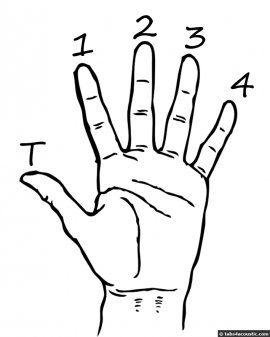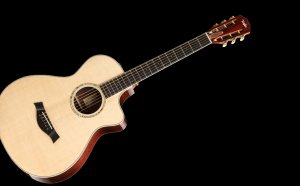
Free Beginner acoustic guitar lessons
A chord diagram is a schematic way to transcribe a chord, and thus a form of written music. You will meet them very often on the web, in the guitar methods, softwares, sometimes in addition to a tab.
How to read a chord
- At the top is the name of the chord, written in two ways : first, the full name (here "C Major"), and second, ("C") the "short" version. This is much more frequently seen on the web, however, when spoken, the full name is generally more used.
- This diagram consists of six horizontal lines and six vertical lines.
- Vertical lines represent the six strings of the guitar. The leftmost line is the low E string, the right the high E string.
- The horizontal lines represent the frets, the top line represents the nut which is down the neck of the guitar, or top, depending on the people, but to be clear: this is the 0 or the "head end" or "mechanical side." The number of horizontal lines can vary depending on the number of frets needed to play the chord.
- On the diagram, there are dots, which are located between two frets. For example at the top right we have one dot numbered "1" placed on the B string, the second string starting from the right, between the first and second line, that is to say between the nut and the first fret This means we have to fret the B string on the first fret.
- The two other dots indicate that we should fret also, and simultaneously, the D string on fret 2 and the A string on the fret 3.
- The figures on the dots indicate which fingers to use on each of this frets, and correspond to the four fingers of the hand that frets the strings, that is to say the hand around the neck (the other hand is used to hit the strings). There are often several fingerings for the same chord, which vary according to context.

- The index is numbered"1"
- The medium finger "2"
- The ring finger"3"
- The little finger"4"
In the few cases where the thumb is used, it is designated by a T (for "thumb”)
Chords and Tablatures
There is still one line that we have not yet spoken about, the line with a series of numbers between the nut and the name of the chord. Here each figure corresponds to the box where the string is fretted. We see the figures 1, 2 and 3 on the B, D and A strings respectively.The"0" means that the strings should not be fretted (left open), the "x" means this string should not be played (not be touched).
This line is representative of what is most frequently found on the web, to illustrate a chord when discussing in a forum for instance.
We can also transcribe the chords in the form of a tablature, we find the figures mentioned above, but the strings are no longer presented vertically but horizontally, the low E string is at the bottom. The same chord, tablature version:
One important thing about chords: one single chord exists in lots of different positions. However the position of "C major" which we mentioned above, belongs to the category of "open" chords, i.e, a chord which is composed of notes played on open-strings. Only two, three, or four out of sixstrings are fretted which make them easier to play.
There is virtually an infinite number of chords. From a musical point of view, a chord is composed of at least three different notes played together, if you fret three notes randomly, you obtain a chord.
Important thing to remember
In most cases, the lowest note in a chord is what is called its "fundamental". It’s usually with this note that we begin to play a chord or an arpeggio, and it’s also this note that gives its name to the chord : in a C chord, the lowest note is C, in a A chord, the lowest note is A, in a D minor chord, the lowest note is D, in a E7add14+b2 chord, the lowest note will be E etc.
5 essential chords
Essential chords are the E minor, A minor, the C major, the D major and G major. You will find all the diagrams for these chords in the appendix to this course, a little lower.
This list is not a definitive list, these chords can be played in different ways, but they have the characteristic to all belong to the same tonality, the tonality of G major, which means you can chain them together one after the other in almost any order, it will sound right.
See also:
- Watch anytime, anywhere with Soap2day.
YOU MIGHT ALSO LIKE



Share this Post
Related posts
Best acoustic Guitar lessons DVD
Dear Guitar Student, Even though the acoustic guitar may very well be the ultimate instrument, I get emails and letters from…
Read MoreFirst acoustic Guitar lessons
Buying your first acoustic guitar can seem kind of overwhelming. When you start looking you quickly realize that there are…
Read More










